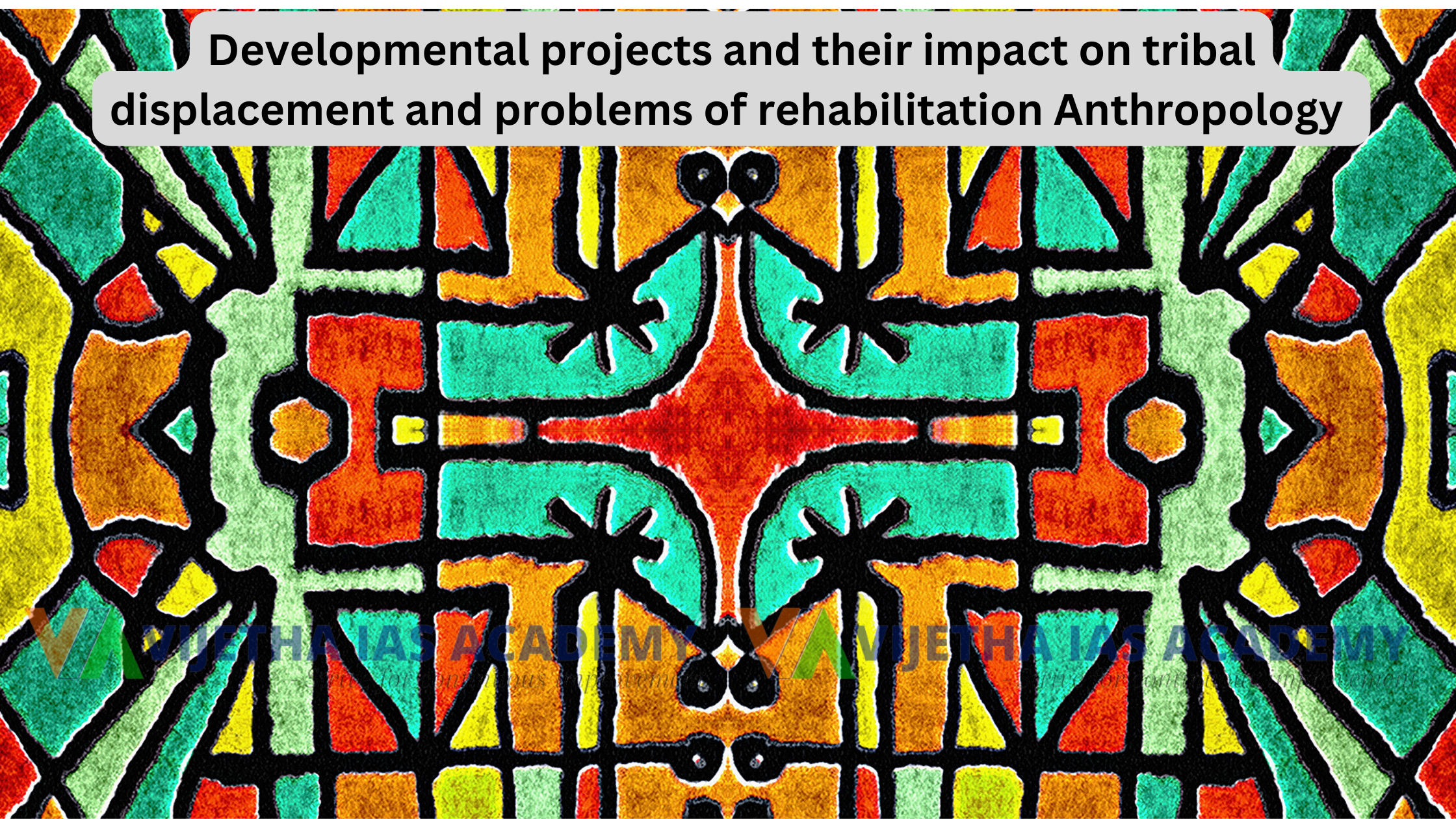
Developmental Projects and Their Impact on Tribal Displacement and Problems of Rehabilitation: Anthropology Optional UPSC
India's path to modernization and economic development has often come at the cost of its tribal communities. Developmental projects such as dams, mining, and industrial expansion have led to significant tribal displacement, causing myriad socio-economic and cultural issues. For UPSC aspirants, particularly those choosing Anthropology as an optional subject, understanding these impacts is crucial. This blog post delves into the effects of developmental projects on tribal displacement and the associated challenges of rehabilitation, while highlighting the role of Vijetha IAS Academy and Kishore sir in guiding aspirants through this complex subject.
Impact of Developmental Projects on Tribal Displacement
Types of Developmental Projects
-
Dams and Hydroelectric Projects:
- Large-scale dams such as the Narmada, Tehri, and Polavaram projects have displaced millions of tribal people, submerging their ancestral lands and homes.
-
Mining and Industrial Projects:
- Mineral-rich tribal areas in states like Jharkhand, Odisha, and Chhattisgarh have seen extensive mining activities, leading to the displacement of local communities.
-
Infrastructure Development:
- Construction of highways, railways, and urban expansion has further contributed to the displacement of tribal populations.
Consequences of Displacement
-
Loss of Ancestral Land:
- Tribals have a deep spiritual and cultural connection to their land. Displacement severs this bond, leading to a loss of identity and cultural disintegration.
-
Economic Hardship:
- Tribals rely heavily on their land for agriculture, forest produce, and livelihoods. Displacement leads to loss of these resources, plunging them into poverty.
-
Social Disruption:
- Forced migration disrupts community networks and social structures, causing psychological stress and social fragmentation.
-
Cultural Erosion:
- Displacement often leads to the erosion of traditional practices, languages, and cultural heritage as tribals are relocated to unfamiliar environments.
Problems of Rehabilitation
-
Inadequate Compensation:
- Compensation provided to displaced tribals is often insufficient and does not reflect the true value of their lost assets. Delays in compensation exacerbate the issue.
-
Poor Implementation of Rehabilitation Policies:
- Rehabilitation programs are frequently poorly implemented, with gaps between policy and practice. Issues include lack of basic amenities, inadequate housing, and failure to provide sustainable livelihoods.
-
Legal and Administrative Hurdles:
- Bureaucratic red tape and lack of awareness about legal rights among tribals hinder effective rehabilitation.
-
Marginalization and Social Exclusion:
- Relocated tribals often face discrimination and exclusion in their new environments, struggling to integrate and access opportunities.
Case Studies
-
Sardar Sarovar Dam (Narmada Valley Project):
- The Sardar Sarovar Dam project on the Narmada River led to the displacement of thousands of tribal families. Despite various protests and the formation of movements like the Narmada Bachao Andolan, issues related to inadequate compensation and rehabilitation persist.
-
Kalinganagar Industrial Complex:
- In Odisha, the establishment of the Kalinganagar industrial complex displaced several tribal communities. The project faced significant resistance, and the lack of proper rehabilitation measures resulted in ongoing conflicts and social unrest.
Relevance in UPSC Anthropology Optional
Understanding the impact of developmental projects on tribal displacement and rehabilitation is a key component of the Anthropology optional syllabus for UPSC. Key topics include:
- Social structure and cultural patterns of tribes.
- Economic organization and livelihoods.
- Issues of tribal identity and integration.
- Policies and programs for tribal development.
- Case studies of displacement and rehabilitation.
Aspirants must develop a nuanced understanding of these issues to effectively address related questions in the examination. This is where specialized coaching and expert guidance are invaluable.
Role of Vijetha IAS Academy and Kishore Sir in Anthropology Preparation
For aspirants aiming to excel in Anthropology optional, Vijetha IAS Academy provides comprehensive coaching that covers the entire syllabus systematically.
Vijetha IAS Academy
The academy offers a meticulously designed course that includes detailed lectures, high-quality study materials, regular tests, and personalized feedback. Their curriculum covers the socio-economic, cultural, and political issues faced by tribal communities in depth, ensuring that students grasp complex concepts effectively. The academy’s focus on current developments and their integration into the syllabus helps students stay updated and relevant.
Kishore Sir Anthropology
Kishore sir, a distinguished faculty member at Vijetha IAS Academy, is renowned for his expertise in Anthropology. His deep understanding of tribal issues and ability to simplify complex topics have made him a favorite among UPSC aspirants.
Kishore sir’s classes on the impact of developmental projects on tribal displacement and rehabilitation are particularly noteworthy. He delves into the socio-economic, cultural, and political aspects, providing students with a comprehensive understanding. His practical approach, including interactive sessions, case studies, and real-world examples, helps students connect theoretical knowledge with practical applications.
Strategies for Success in Anthropology Optional
To excel in Anthropology with a focus on the impact of developmental projects on tribal displacement and rehabilitation, aspirants should adopt a strategic approach:
-
Comprehensive Understanding: Develop a thorough understanding of the syllabus, focusing on key topics related to tribal communities and development issues.
-
Quality Resources: Utilize standard textbooks, research papers, and study materials provided by reputed coaching institutes like Vijetha IAS Academy.
-
Regular Revision: Make concise notes and revise regularly to retain concepts. Regular revision is crucial for mastering the subject.
-
Answer Writing Practice: Practice writing answers to previous years’ questions and mock tests. Focus on structuring your answers logically and incorporating relevant examples.
-
Stay Updated: Keep abreast of current developments, government policies, and socio-cultural issues related to tribal communities. Integrating current affairs into your answers will enhance their relevance.
Conclusion
The impact of developmental projects on tribal displacement and the problems of rehabilitation are complex and multifaceted issues that are critical for UPSC aspirants to understand. With expert guidance from institutions like Vijetha IAS Academy and seasoned educators like Kishore sir, candidates can develop a comprehensive understanding and strategic approach to excel in the examination.
